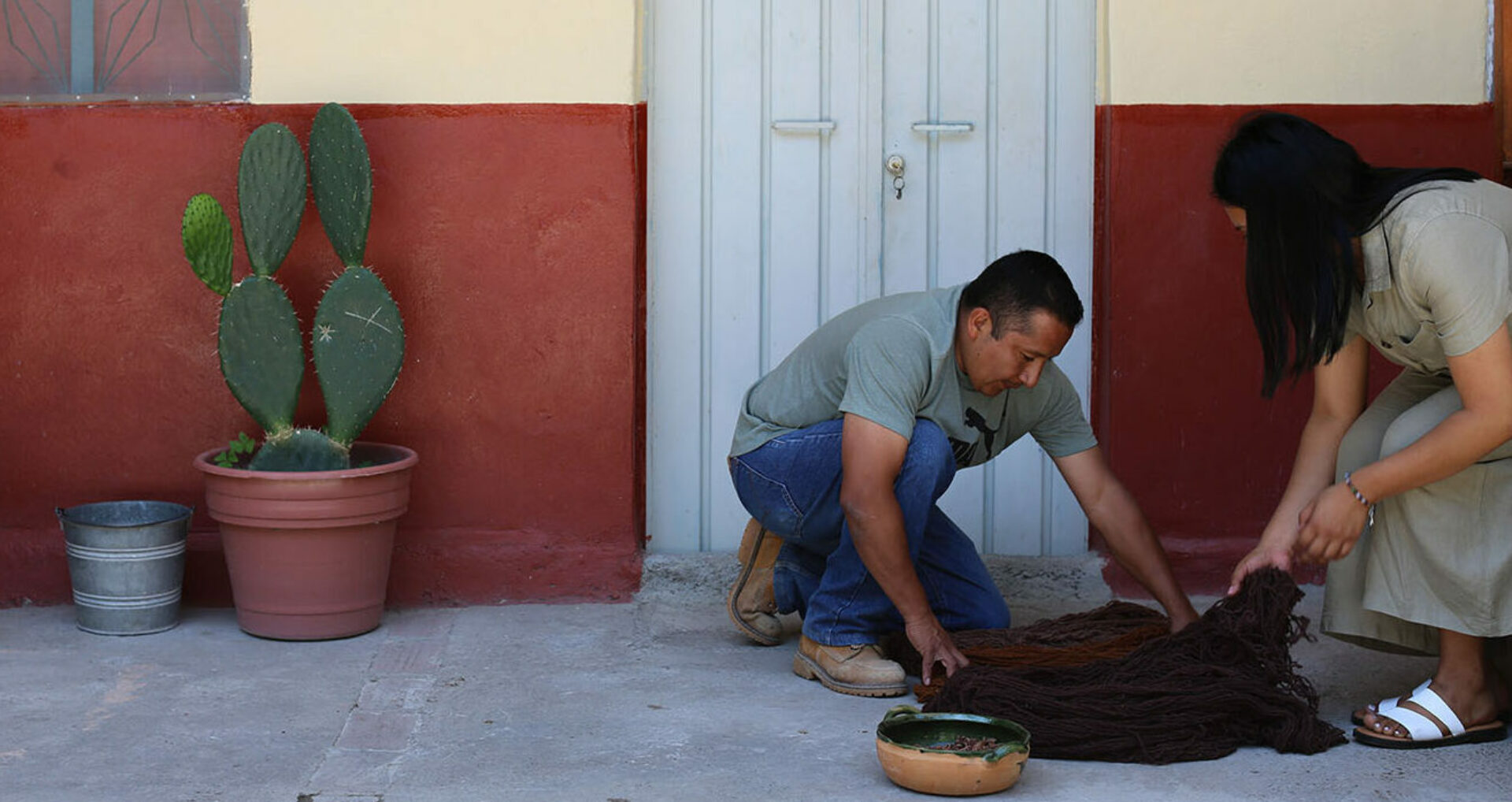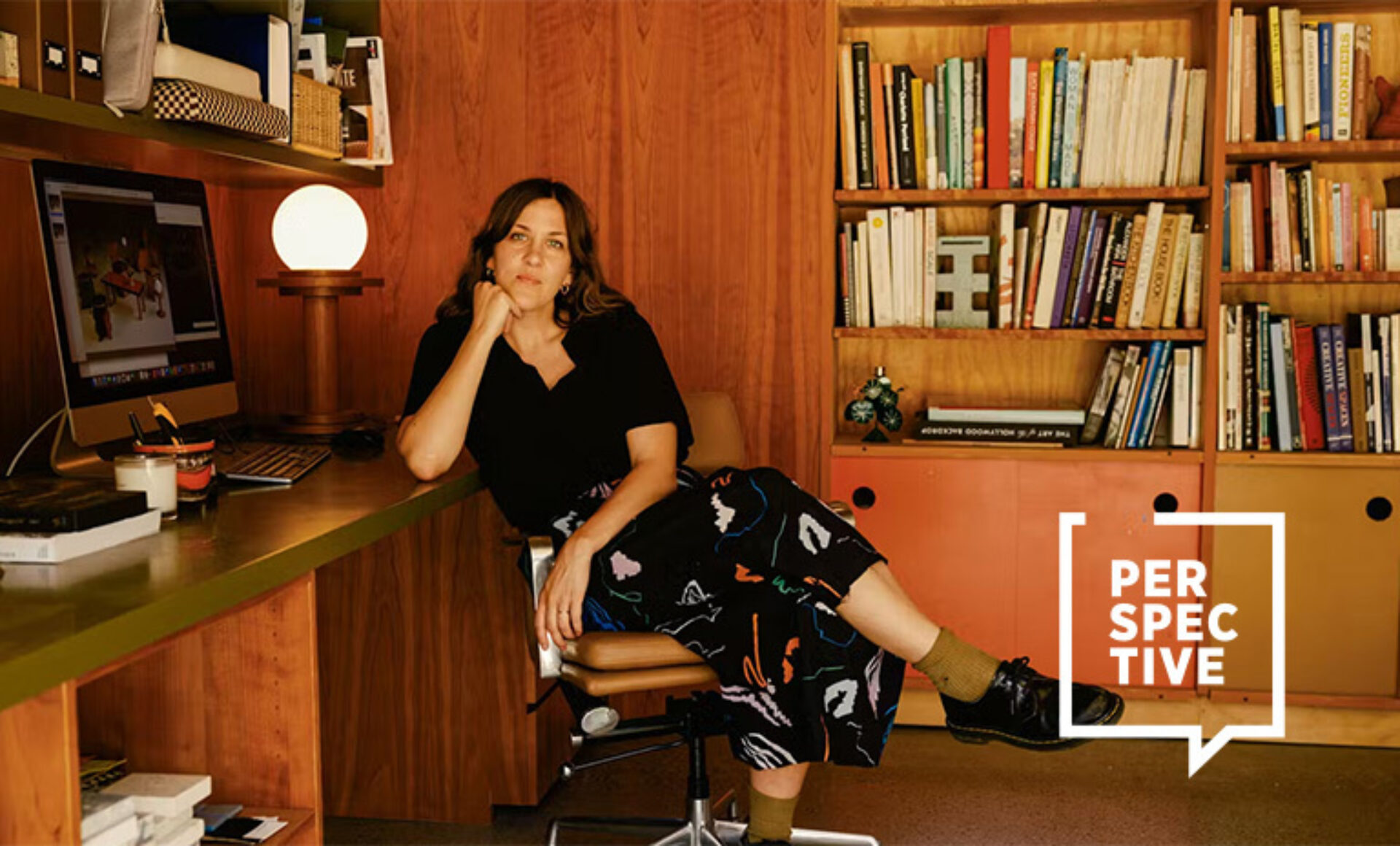(Above image: Jezarely Miguel works with local artisans in Oaxaca to produce high-quality, small-batch rugs. Image courtesy of Diana Mata.)
Named after the Spanish word for hue, Matiz was founded by Jezarely Miguel, Ind. IIDA, with the mission to preserve Mexican handmade textile traditions. The LA-based interior designer’s, high-quality, small-batch rugs are produced by artisans in Oaxaca, Mexico, using locally sourced materials from Teotitlan del Valle. Both a nod to Miguel’s cultural roots and an embrace of traditional craftsmanship, Matiz focuses on artistry and ancestral techniques. The company’s dedicated team of artisans practices rug-making methods passed down for generations—paired with Miguel’s contemporary designs, the result is truly one of a kind.
“Jezarely blends her cultural roots through collaboration and community impact to bring people together through innovation and the power of design,” said IIDA Executive Vice President and CEO Cheryl S. Durst, Hon. FIIDA, about Miguel, who received this year’s Anna Hernandez/Luna Textiles Award. “This blend embodies the significance of Anna Hernandez’s dream of seeing women thrive in leadership, ingenuity, and steadfast commitment to storytelling in the industry.”
Design storytelling is deeply woven into Miguel’s work. Matiz’s first two collections were inspired by Oaxaca’s mountainous terrain and vibrant architecture and aim to convey the city’s essence—with sustainability in mind. Both collections were produced with minimal waste and no carbon footprint.
While Matiz is only three years old, Miguel has been part of the commercial interior design industry for nearly a decade. Before founding the artisanal rug company, she worked at a Portland-based furniture dealership and at architecture and design firm Hennebery Eddy Architects, where she contributed to numerous projects, including a concourse expansion at the Portland International Airport. We caught up with Miguel about the evolution of her design career, the profound influence of her Mexican heritage, and how sustainability and community engagement are paramount to her work. Receiving the Anna Hernandez/Luna Textiles Award is just the beginning of Miguel’s, and Matiz’s, next chapter.
Responses below have been lightly edited for length and clarity.
What are some of your earliest design experiences and influences?
From the beginning of my career journey, I was open to any and all opportunities. When you stay curious and are willing to explore different avenues, the possibilities broaden—and by giving every opportunity a chance, you eventually find your true passion in design. When I began seeking my first job, I knew that mentorship was valuable to my career development and growth, so I looked for a supportive environment. From my experience in the furniture dealership world to my A&D position, I was very fortunate to be surrounded by women in design—women who were encouraging, trusting, and most importantly allowed me to feel integrated and part of the company and project team by giving me ownership of various tasks, responsibilities, and roles. They all had a diverse range of strengths, and I was so fortunate to learn from them. Those women influenced the designer I am today.

Founder, Matiz
2024 Anna Luna Recipent
How has your Mexican heritage influenced the aesthetic and mission of Matiz? Where do you look for inspiration?
For a very long time, I was uncertain of how my heritage could be reflected in my professional work. Until I created Matiz. It was the perfect opportunity to fully express my heritage through design and reconnect with my family’s roots. Matiz is proudly made in Oaxaca and inspired by Oaxaca. Which is why I dive in deeply to what Oaxaca signifies to me—rich culture, colorful streets, rugged geography, and everything in between. My collections are designed to tell stories, educate, and uplift the culture and people who make up Mexico, but especially Oaxaca. To date, my collections reflect just a small portion of what I see and experience there. Collection No. 1 is a representation of Oaxaca’s topographical maps—two of which represent where my parents are from. The yarn colors were intentionally selected to represent the uniqueness of both my parents’ regions. Collection No. 2 focuses on embracing the architectural elements and colorful facades of the city—it’s about the experience of walking through the streets, stepping back, and truly taking the time to admire the history, the wear, the patterns, and the elements that make the city so special and alive.

Diana Mata.

Sustainability and community engagement are central to your work. Can you talk about how these principles are integrated into your production process in Teotitlan del Valle, Oaxaca?
Now more than ever, sustainability is crucial for our present and future, and as designers, I believe we have a big responsibility to positively impact our profession and planet. The wool rug-weaving craft was a natural choice for me when I learned of the production process and the artisans behind it. When I approached my team in Teotitlan del Valle, I was so inspired by their passion and excitement for the craft that I only wanted to add to it by supporting them and providing an opportunity to continue their skills and expertise.
I find it beautiful that we have the privilege to use Earth’s natural resources to create beautiful products. Each of our unique, naturally dyed wool yarns represents a local material in Oaxaca—flowers, moss, herbs, nut shells, cochineal, indigo, and the list goes on. It’s truly an eye-opening experience to see our products handmade from start to finish and, most importantly, knowing that we are contributing to the health and well-being of our planet.
What’s the best piece of advice you can give to emerging designers?
Stay curious. Curiosity is essential for enhancing our education. We must be willing to learn new things, both inside and outside of our industry. Secondly, stay engaged and connected with your peers, mentors, and the community, and take time to understand each individual’s story. These stories provide different perspectives, methods of work, and new insights that you may not otherwise encounter in your day-to-day life. And lastly, think beyond what’s standard. The beauty of our industry lies in all the different paths you can take, all the ways you can contribute to design by stepping out of the norm to provide a solution.

Kateshia Pendergrass.

Diana Mata.
How does receiving the Anna Hernandez/Luna Textiles Award contribute to the future projects and growth of Matiz?
Matiz will continue to expand its product line, providing opportunities for other artisans in Oaxaca and developing designs that are intentional and educational. The monetary award will allow us to explore other materials and design expressions, pursue sustainability with full force, and continue to educate ourselves on Oaxaca’s heritage crafts—and how we can contribute to these textile traditions with a modern approach.

Diana Mata.

Diana Mata.






